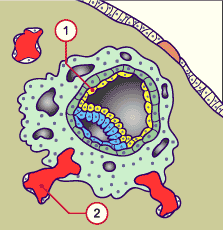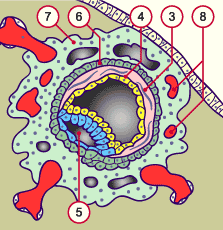
1
2
|
Multiplying hypoblast
Eroded maternal vessels |
|
|
|

3
4
5
6
7
8 |
Extra-embryonic reticulum
Heuser´s membrane
Amniotic cavity
Cytotrophoblast
Syncytiotrophoblast
Lacunae, some of which are filled with blood |
|
|
|
Fig. 7, Fig. 8
The destructive activity of the ST reaches the capillaries of the endometrium. Maternal blood flows into the lacunae. The ST envelops the maternal capillaries, enlarges its network of lacunae and forms an arterial in- and venous outflow system.
|

